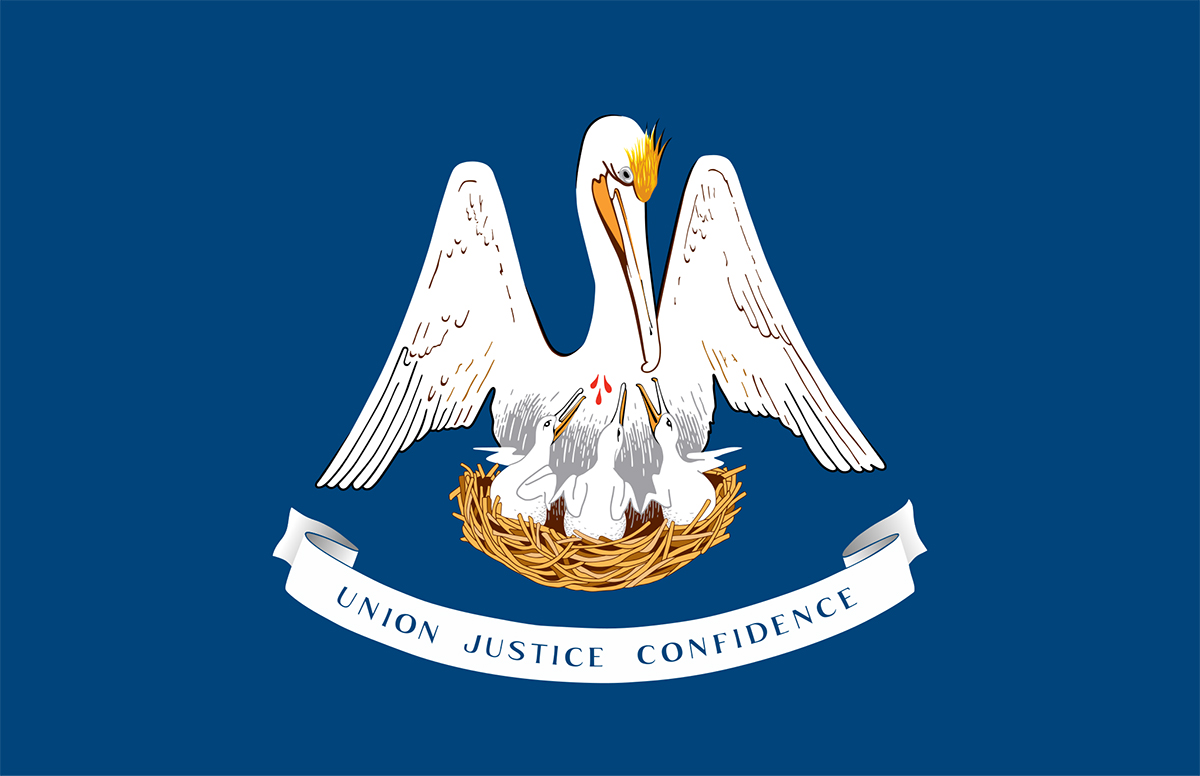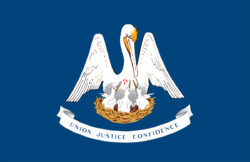Louisiana State Flag
Centered on a blue field, the Louisiana State Flag features a nest of pelicans above a white banner, or ribbon, inscribed with the state motto: “Union Justice Confidence.”

Louisiana Secretary of State
Current state flag of Louisiana, 2010.
The Louisiana state flag features a mother pelican piercing her breast with her beak to feed her three nestlings with drops of her own blood. Called a Pelican in her Piety, or a vulning pelican, it’s a ubiquitous symbol of the Catholic Church. Rooted in pre-Christian myths, the Pelican in her Piety is said to have revived her nest of dead baby chicks by feeding them with her blood. That act came to represent Christ’s sacrifice for his flock.
Centered on a blue field, Louisiana’s nest of pelicans hovers atop a white banner, or ribbon, inscribed with the state motto: “Union Justice Confidence.”
Curiously, the brown pelican was not Louisiana’s first bird of choice. Following the Louisiana Purchase of 1803, Governor William C. C. Claiborne picked the bald eagle to officially grace the state seal, the state’s official government emblem. It was a symbolic gesture indicating allegiance to Louisiana’s new American masters rather than its French and Spanish colonial founders.
After Louisiana became the nation’s eighteenth state in 1812, Governor Claiborne replaced the bald eagle with a pelican, most likely to appease the state’s Catholic citizenry (it also helped that brown pelicans outnumbered bald eagles in the state). The switch was met with grumbles elsewhere. “The people of the new State,” a Nashville newspaper editorial commented, “have strange ideas.”
That first seal depicted a Pelican in Her Piety hovering over a nest filled with ten chicks, instead of the traditional three. Except during Louisiana’s Confederate era, when the state legislature adopted a flag featuring a yellow star and thirteen stripes, at least a half dozen different pelican designs have decorated the state seal and flag. The pious pelican sometimes faced left, other times right. Pelican nestlings numbered anywhere between three and a whopping eighteen. Sometimes the mother pelican looked like a vulture, other times a raptor. One seal showed her hovering over the nest, while another common flag design pictured birds that resemble cartoon animation characters.
Most confusing of all, the majority of these designs featured what looked like an American white pelican, a sister pelican species that winters in Louisiana but does not reside in the state year-round like the brown pelican.
In 1912 the state legislature finally officially declared the pelican flag—whatever its design—the official state flag. They didn’t codify the design beyond the following: “the pelican feeding its young, in white in the center, with a ribbon beneath, also in white, containing in blue the motto of the State.”
The state motto, perhaps unsurprisingly, was also not officially enshrined in law. Different versions of the seal and flag have swapped out word ordering, commas, and conjunctions to read, over time: “Justice, Union & Confidence”; “Union, Justice, Confidence”; “Union, Justice & Confidence”; and “Union, Justice and Confidence.”
In 1958 legislators finally passed an amendment that designated the “pelican”—though a generic, non-designated-species of pelican—as the state bird. Several years later, in 1966, they revised the amendment to name the brown pelican as the state bird. Ironically, because the species’ local population had been recently decimated by pesticide poisoning, there were no brown pelicans living in Louisiana at the time.
Debates over the pelican flag made the rounds again in 2005, after David Joseph Louviere, a Houma eighth grader, noticed that a flag he owned, one that had once flown over the state capitol, featured the traditional three drops of blood. Many other flags, he observed, including some that were still flapping across the capitol parade grounds in Baton Rouge, were entirely bloodless, a shrewd cost-saving measure by flag manufacturers. After presenting his findings in a social studies class project, Louviere wrote to his state representative just months after Hurricane Katrina, when the failure of the federal levee system devastated parts of the state. Testifying in Baton Rouge the following year, Louviere said that Louisianans deserve a standardized flag design, “especially during a time like this when Louisiana is in recovery.”
Lawmakers quickly passed a resolution calling for “an appropriate display of three drops of blood.” Curtis J. Vann Jr., the designer of the latest seal and flag, also added a golden-brown tuft of feathers atop the mother pelican’s crown to make the bird look more like a member of her species. The motto, sans punctuation and conjunctions, became simply: “Union Justice Confidence.” That design was made official in 2010.
Still, the new design has its share of detractors, who argue that the stark, white-feathered pelican family continues to resemble the brown pelican’s sister species.
